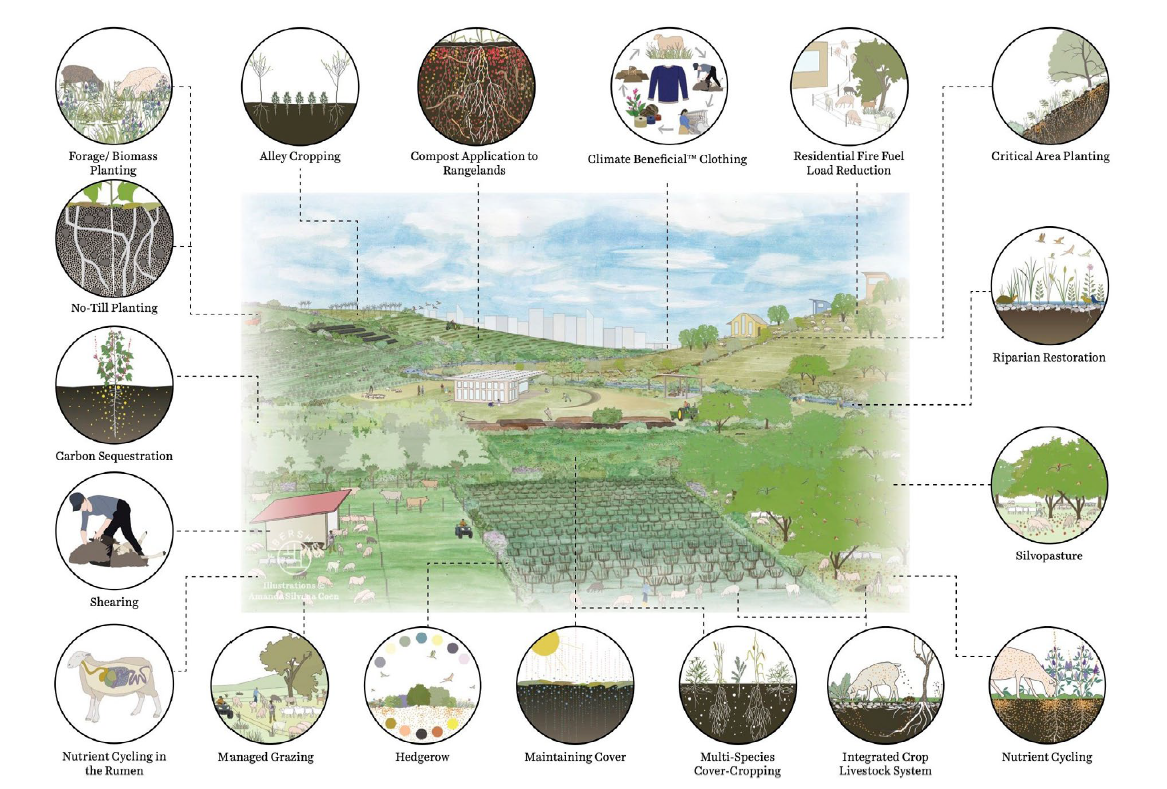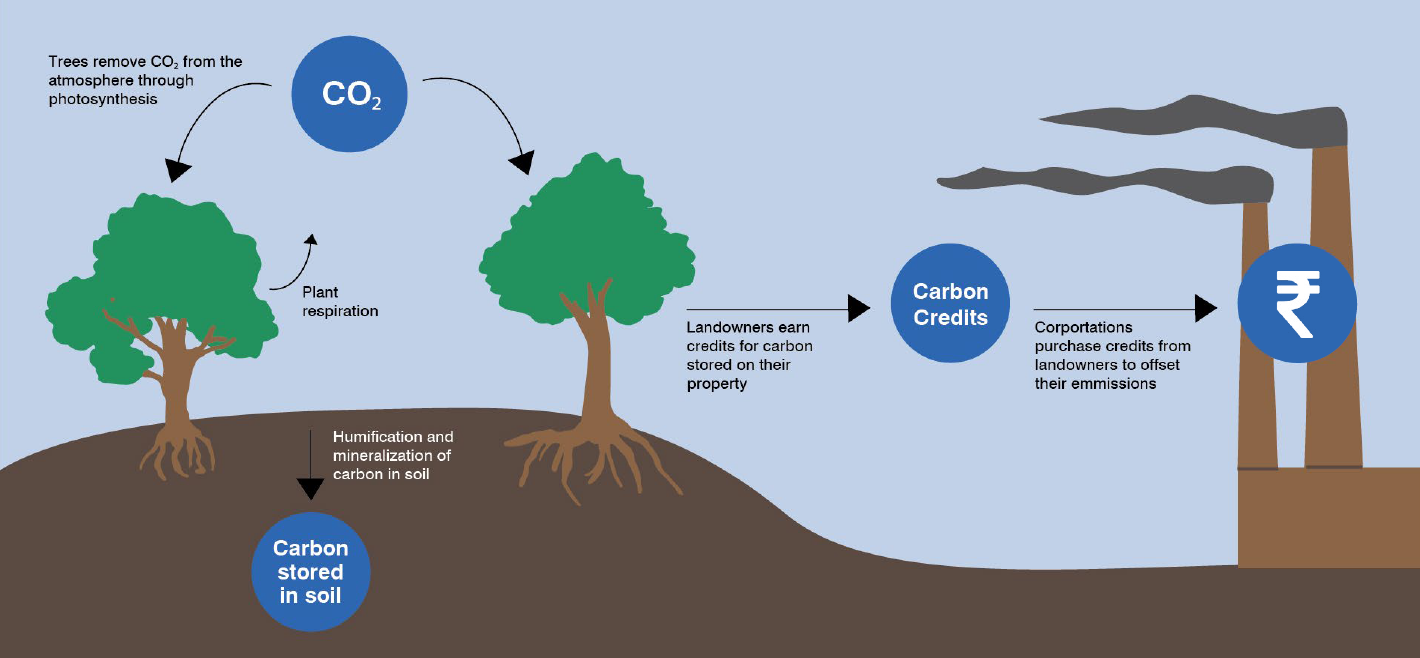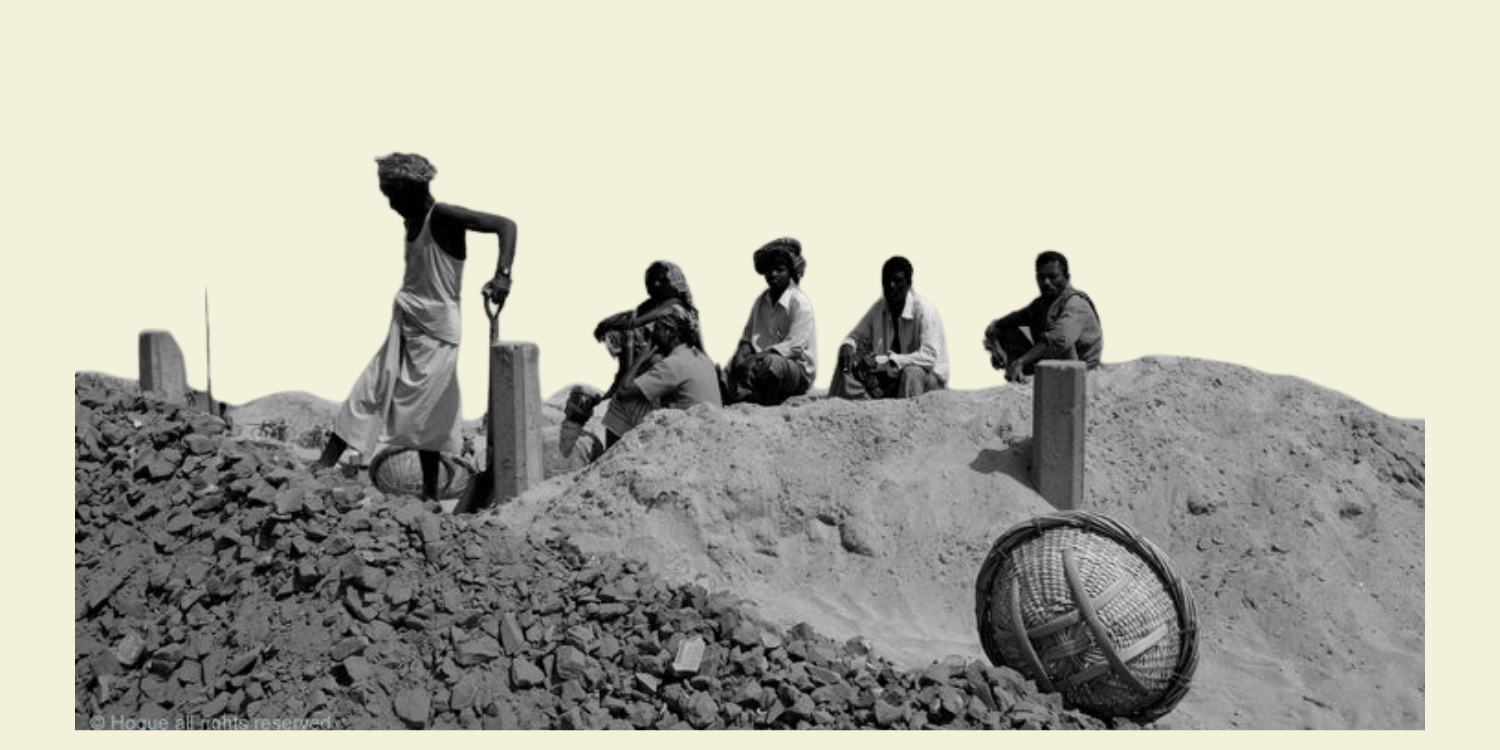Abstract
Agriculture is a significant employer and contributor to the GDP in India. However, the sector faces a two-fold problem due to climate change and a declining workforce. On the one hand, increased food demand is juxtaposed with a decline in the number of food providers – farmers. On the other hand, agriculture has to face the brunt of, while also exacerbating, climate change.
The recently passed Energy Conservation (Amendment) bill proposes a domestic carbon credits market, which can act as a thrust toward solving both these issues. An emissions market can incentivise farmers to decarbonise agriculture while also increasing their incomes through the sale of credits. Carbon farming can help drive decarbonisation forward. This discussion paper identifies existing problems of the inaccess to technology, fragmented landholdings, and the nature of a voluntary market as possible hurdles for the effective participation of farmers in a carbon market. Further, it analyses the role of agritech startups, collective farming, and regulation of an emissions market in achieving the twin objectives.
Keywords
Carbon farming, carbon markets, agritech in India, collective farming, climate change.
Introduction
The Energy Conservation (Amendment) Bill was passed in the Rajya Sabha in December 2022. The Bill lays down a framework for regulating energy consumption and promoting energy efficiency and conservation. More importantly, the Bill empowers the central government to specify a domestic carbon credit trading scheme. Globally, entities have used the voluntary carbon market1 as an incentive to decarbonise agriculture and increase incomes from agriculture and related activities. Consequently, exploring the role of a domestic carbon credits market in India’s agricultural practices is vital in both decarbonising and revitalising India’s agricultural sector.
The agriculture sector in India employs 54.6% of the population and contributes 17.4% to the country’s GDP (Department of Agriculture and Farmer Welfare, n.d.). The sector accounts for farming and non-farming activities that aid crop production and livestock management. The produce of agricultural activities serves both as a finished product for consumption and an intermediary product for further production. Given India’s growing population, the country will have to increase its agricultural production by 70% to cater to a growing population (Kishor, 2021). A predominant part of this increase can be expected in crop production to ensure food security. However, increased agricultural production will increase carbon emissions, given the carbon-intensive nature of the sector. Hence, scientists and policymakers are tasked with fulfilling rising food demand while also reducing greenhouse gas [GHG] emissions.
On the other hand, an increase in food demand is juxtaposed with a decrease in the number of farmers. Data shows that more people are quitting or not taking up agriculture, thereby increasing the average age of an Indian farmer to around 50 years (Mahapatra, 2020). Government efforts towards urbanisation are also expected to change the makeup of the economy due to a change in people’s occupational preferences. An imminent concern, therefore, is the switch to more remunerative non-farming occupations and the ability of such jobs to absorb a predominantly rural youth population.
This discussion paper identifies climate change and poor income as two of the biggest challenges faced by the agriculture sector in India. The paper builds on the proposed carbon credits market under the 2022 Energy Conservation (Amendment) Bill. It highlights the benefits of using agritech, collective farming, and regulating the emissions market in decarbonising crop production and increasing farmer incomes.
Situating Agriculture in the Supply Chain
A supply chain is a series of processes and activities to procure raw materials, produce, and distribute finished goods and services. This involves various actors acting as producers, suppliers, and consumers. Agriculture can be placed within the supply chain early on since it is a major supplier to downstream businesses2.
With increasing discourse around making supply chains greener and more sustainable, agriculture will play a major role in responsible sourcing. Responsible sourcing, or supply chain responsibility, is the voluntary commitment by companies and businesses to account for social and environmental considerations when managing relationships with their suppliers (International Chamber of Commerce, 2008). Supply chain management is expected to propel downstream businesses to seek out environmentally conscious suppliers to offset carbon emissions from their value chains. Given that agriculture is not just about food security but also production activities, it becomes vital for the sector to adopt sustainable practices. Producers actively seeking greener and less carbon-intensive agriculture, moreover, can help increase farmer incomes and the general productivity of the sector. To make their supply chains greener, businesses are more likely to procure materials from farmers who undertake greener agricultural practices, thereby offsetting carbon emissions.
There is an urgent need to transition agricultural practices in India from traditional methods to more modern, innovative methods. The reasons for this transition are twofold – increasing farmers’ income to incentivise younger generations and inculcating sustainable farming practices.
1. Poor Remuneration and Fewer Farmers
Mahapatra (2020) outlines a significant conundrum in the Indian economy – the percentage of farmers in the national workforce is declining slower than agriculture’s total GDP share. As unwillingness to take up agriculture increases, India faces the existential question, ‘who will produce food?’. According to the Ministry of Agriculture and Farmer Welfare’s Input Survey 2011-12, the greatest percentage of operational landholders (33.7%) lies between the ages of 41-50 (ibid.). This statistic is followed by the age group of 51-60, accounting for 33.2% of operational landholders. The rising input costs and poor wages demotivate the upcoming generation from farming, while the current generation is approaching retirement age.
The Committee on Doubling Farmers’ Income’s 2017 report highlights a sharp increase in material input costs. Over time, increased input cost has resulted in a decline in net income from agricultural activities. Based on a comparison of the trends in the wholesale price index [WPI] of agricultural inputs purchased, such as fertilisers, fuel, and food items, the committee found that the WPI of agricultural inputs was lower for most years (Chauhan, 2021). This finding showed that farmers earned lower market prices for agricultural products than what they paid to buy inputs.
Even with initiatives such as Doubling Farmers’ Income, data records inadequate progress towards goals. The compound annual growth rate of farmers’ real income was estimated at 2.84% in 2019 (SPRF India, n.d. a). Calculations show that in nominal terms, the expected income would be Rs. 1,33,567, falling short of the committee’s target of a nominal income of Rs. 1,63,456 (ibid.). However, the economic viability of agriculture must be measured not just by calculating farmers’ incomes but also by their indebtedness. While data shows a positive sign of reduced indebtedness by 5.64% among overall farmers in the country, a flipside to this discussion is the increased indebtedness among 19 states3 (SPRF India, n.d. b).
2. Agriculture and Climate Change: A Chicken-and-Egg Problem
The first instalment of the Sixth Assessment Report [AR6] released by the Intergovernmental Panel on Climate Change [IPCC] highlighted the impact of extreme weather conditions on agriculture. The South Asian subcontinent is expected to experience increased temperatures, erratic rainfall, flooding, and water shortages in the coming years. Moreover, the yields of food and cash crops in South Asia are anticipated to decrease as temperatures rise, placing stress on the region’s food security (Guram, 2022).
Agriculture is both a victim of and a contributor to climate change. Due to the use of chemical fertilisers, pesticides, and animal manure, agricultural operations, on the one hand, are responsible for around 10-12% of the world’s total greenhouse gas emissions (Devakumar & Sah, 2018). According to Climate Watch (n.d.) data, India’s agriculture sector emitted 719.82 metric tons of carbon dioxide equivalent [MtCO2e] of greenhouse gases [GHG] in 2019. Currently, the sector accounts for 18% of the country’s GHG emissions (Sawhney, 2022a). This rate is anticipated to increase in the coming years due to the increased food demand of a growing population.
On the other hand, these greenhouse gases also include nitrous oxide [N2O], carbon dioxide [CO2], and methane [CH4], all of which have a substantial impact on the sustainability of agricultural production systems since they all contribute to climate change and global warming (Devakumar & Sah, 2018). Adopting high-yield crop varieties and other agricultural technology after the Green Revolution are examples of output-centric farming techniques that have enhanced farm produce but also raised emissions. Cereal crops, especially rice, have the highest emissions due to their extensive land covering and greater carbon intensities (ibid.). Among the various inputs used in crop production, inorganic nitrogen fertiliser is responsible for the most significant amount of emissions (ibid.).
This chicken-and-egg dilemma of agriculture and climate change mandates the need to accomplish two things. First, making agriculture an environmentally sustainable and viable economic activity with a lesser carbon footprint. Second is sustaining agriculture in light of the climate crises that directly affect agricultural production.
One way to make farming and agriculture more sustainable is by incorporating the concept of carbon credits and carbon farming with agriculture.
What are Carbon Credits and Carbon Markets?
In December 2022, The Energy Conservation (Amendment) Bill was passed in the Rajya Sabha. The bill calls for the central government to lay down a carbon trading scheme in India which will enable the trade of carbon credits or certificates in the country (PRS Legislative Research, n.d.).
The system of carbon credits was officially set up in 1997 in Japan during the United Nations Framework Convention on Climate Change [UNFCCC]. Carbon credits were introduced as a part of the Kyoto Protocol, the first international agreement to commit to bringing down global emissions. Carbon credits, also known as carbon offsets or carbon allowances, are tradable permits that allow an individual or an organisation to emit a set amount of carbon dioxide or other greenhouse gases (Kenton, 2022). The system of carbon credits converts carbon dioxide and GHG emissions into commodities that can be purchased, sold, earned, or traded (The Ultimate Guide to Understanding Carbon Credits, 2022). One carbon credit permits an organisation the emission of one ton of carbon dioxide or the equivalent amount of other greenhouse gases. The credit expires after one ton of greenhouse gases are emitted and is moved to a register of retired credits, which can no longer be used or traded. Any credits not used by a particular entity can be resold, provided the entity hasn’t made claims of reducing emissions using those credits.
In 2001, 191 nations ratified the Kyoto Protocol agreement in Germany, and the idea of carbon markets was proposed (Kenton, 2022). Carbon markets are trading setups where carbon credits can be purchased or sold. Presently, carbon markets are of two types:
1. Compliance Carbon Markets:
Compliance carbon markets are also known as cap-and-trade markets. Regional or international carbon reduction regimes regulate these markets. Permits are generally issued or sold by governments to corporations based on their emissions history. Some examples of cap-and-trade systems can be seen in the state of California, China, and the European Union. For instance, under a cap-and-system, two companies, A and B, are allotted 100 carbon credits, allowing them to emit 100 tons of greenhouse gases. Company A emits only 80 tons of greenhouse gases, with 20 extra credits. Company B estimates it will emit 120 tons of greenhouse gases, which is 20 tons above the permitted limit. In this situation, company B can purchase the excess carbon credits that company A has, thereby purchasing the rights to emit the extra 20 tons of greenhouse gases.
2. Voluntary Carbon Markets:
These markets function outside compliance markets and are set up by private entities. In a voluntary carbon market, companies and individuals can choose to offset their emissions by purchasing carbon credits. Voluntary carbon markets are more flexible and are not confined by regional or geographic boundaries (Favasuli & Sebastian, 2021).
The proposed nature of the carbon trading setup in India is a voluntary trading setup, but the scheme lacks a definition.
What is Carbon Farming?
The practice of storing carbon in the soil is known as carbon farming. Carbon farming generally involves making a single change in land management, such as zero tillage, agroforestry, stubble retention, using methane-reducing feed supplements, using carbon-enriched soil, etc., to maximise the retention of carbon in soil and remove carbon from the atmosphere. This removal of carbon from the atmosphere is called carbon sequestration (Carbon Cycle Institute, n.d.).

Figure 1 Source: Carbon cycle institute (n.d) Various carbon farming practices
Carbon sequestration through carbon farming opens possibilities for climate-friendly agriculture that benefit all stakeholders. It can enhance the soil profile, reduce fertiliser use, improve overall crop health, improve the resiliency of farmers, and lead to lesser greenhouse gas emissions while earning the farmers carbon credits (Sawhney, 2022b). However, the pricing of carbon credits needs to be higher than what it costs to transition towards carbon farming to maintain the interest of the farmers. Farmland owners who incorporate carbon farming into their farming practices to earn credits can sell their credits to companies that then use them to offset the climate impact of their operations (Plume, 2021).

Figure 2 Source: Welch (2022) How carbon sequestration and offset credits work
However, there are certain steps that farmers need to take before implementing carbon farming. Carbon farming is a scientific approach to agriculture that uses data to understand how farming practices can be changed with optimal results. For this purpose, an initial analysis of the farmland is necessary to understand the current state of the farm. This step is important because it helps choose the appropriate carbon farming methods for the farm. After setting up the guidelines and choosing the recommended farming practices, farmers and landowners must implement these practices on ground. During this process, it is vital to have data upkeep to review and change farming practices if required. After the recommended farming practices have been implemented, the results and changes need to be verified by third parties or carbon farming program providers. Calculations must include the total amount of carbon dioxide removed or reduced by a farm. Following verification, farmland owners are issued carbon credits or certificates (Rosende, 2022).
With yields becoming unpredictable due to climate change and related weather fluctuations, carbon farming offers a financial incentive to farmers, in addition to the environmental benefits (S&P Global, 2022).
Problems in Implementing a Carbon Farming System in India
Implementing nationwide carbon farming practices in India can be challenging, given the myriad of issues prevalent in the agricultural sector in the country.
1. Lack of Assessment Tools and Technology
As mentioned earlier, proper surveys and data collection needs to be conducted before carbon farming is implemented in any farm or land holding. Most landowners and farmers in India do not possess the resources to invest in technologies and tools required for assessing farm conditions and other prerequisites. Additionally, a majority of the land holdings in India belong to small and marginal farmers who do not have sufficient resources, further aggravating the technological gap (Nishi, 2022).
As mentioned earlier in the paper, carbon farming requires the use of precise measurement tools and instruments. Data collection is an important component of carbon farming, from the initial screening to the post-farming phase. This data collection and analysis of the collected data would require certain digital tools, which are expensive and require expertise. Additionally, certain carbon farming practices will have to be mechanised, a luxury that most small farmers and landowners cannot afford.
2. Fragmented Landholdings
According to the tenth agricultural census, the number of small and marginal agricultural land holdings, that is, operational holdings under 2 hectares [ha], has marginally increased in 2015–16 compared to 2010–11 (Krishnan, 2018). With a 1.2 percentage points increase from 2010-11, small and marginal holdings constituted 86.21% of the total land holdings, but with a 1.5% decline in the operational area (ibid.). Yet, small and marginal land holdings account for the maximum (47.3%) of the country’s total operational area. Given their abundance, sustainable agriculture growth and food security of the nation depend on the performance of these small and marginal farmers.
The average size of operational holdings has declined from 1.15 ha in 2010-11 to 1.08 ha. in 2015-16 (Department of Agriculture, Cooperation and Farmers Welfare, 2020). This indicates an increased fragmentation of operational land holdings. As evident during the Green Revolution of the 1960s and 70s, and even beyond that, the mechanisation of farmlands became difficult for smaller land holdings (Aryal et al., 2021). Smaller landholdings required heavy investments with little returns on mechanisation (National Bank for Agriculture and Rural Development, 2018). Given that the size of the average land holding in India is 1.08 hectares, western styled mechanisation and corporate farming cannot be implemented effectively. Additionally, a bulk of the farmers in India need more resources to obtain the required skills and techniques to implement agritech in their practices properly. Small farmers and landholders are also hesitant to adopt digital technology since they have yet to receive immediate benefits (Jain, 2022). Poor connectivity and infrastructure deficit in rural areas further impact accessibility and the spread of information. Therefore, policy measures will have to be adopted for access to assessment tools, credit, and technology to implement carbon farming practices successfully.
3. Uncertain Nature of Voluntary Carbon Markets
As mentioned earlier in the paper, the proposed carbon trading setup in India will be a voluntary carbon market. Voluntary carbon markets are riddled with various problems. Greenwashing4 can be a possibility in voluntary carbon markets (Hours, 2021). Carbon credits in a voluntary carbon market give a relatively cheap and easy fix to ‘cancel out’ emissions and can effectively delay meaningful action such as innovation and shifting towards sustainable business practices by organisations. Voluntary carbon markets are also dominated by credits generated in agriculture and forestry, meaning they have diminishing returns over time due to the limited availability of land. Additionally, tracking traded carbon credits in a voluntary market becomes cumbersome due to the volume of trades (ibid.). Voluntary carbon markets have no provision for price regulations, making farmers and landholders vulnerable to exploitation by large corporations, which can lead to farmers opting out of the carbon market ecosystem.
Solutions and Recommendations
The interaction between carbon credit markets and farmers is anticipated to change over the next several years as more and more nations make climate pledges. However, given the numerous advantages of increasing soil carbon levels, it may be the push that encourages the growth of regenerative farming methods and contributes to the fight against climate change. Nonetheless, an increase in farmers’ incomes and the transition toward greener agriculture by leveraging an emissions market, with carbon farming as a catalyst, will have to tackle the problems of lack of technology, agricultural land fragmentation, and possible non-participation due to the voluntary nature of the proposed carbon market. The aforementioned dilemmas can be addressed via the following recommendations:
1. Agritech for Technological Access
Globally, the agriculture industry has witnessed a complete overhaul over the last 50 years. Advancement in technology has improved the scale, speed, productivity, and efficiency of farming equipment, leading to more efficient cultivation of land and increased yields. Presently, the sector is seeing yet another revolution with the integration of artificial intelligence, analytics, high-tech sensors and other technologies that could further increase yields and develop crop resilience (Katz et al., 2020). Combining traditional technologies with modern agritech can potentially benefit small farmers and landholders. Digital technologies and agritech have the following benefits:
- Increasing access to data, thereby reducing misinformation and eliminating information asymmetry. This, in turn, leads to better communication along supply chains and value chains.
- Lowering operation and transaction costs by reducing manual data entry errors.
- Improving crop yield through data analytics, artificial intelligence and machine learning.
- Increasing the ability of farmers to engage in sustainable farming practices (Goh, 2022).
Aside from digital technologies, there are other innovations, such as new types of hybrid seeds and fertilisers, which further help in increasing crop resilience and yield.
1.1 Agritech Scenario in India
Even though more than 54% of India’s population is engaged in agriculture, the Indian agritech sector is still in its initial stages (Badri Narayan et al., 2021). Presently, India has around 500 agritech startups helping farmers in every stage of agri-business, from procuring farm inputs to retailing output. Given the rapid growth of the agricultural sector in India, the challenges of the sector continue to be related to weather, soil, irrigation, quality of seeds, etc. Advancements in meteorological sciences backed by digital technologies like big data and artificial intelligence are making farming in India more predictable and crops more resilient to natural fluctuations like climate change. Certain smaller-scale technologies, such as drone technologies, can play a major role in improving certain farm operations. Presently, drones are used for field mapping, collecting soil type data, agricultural spraying, and seed plantation. Drones have the added benefit of better resource utilisation, reduced costs, and higher efficiency in Indian farms (Agarwal, 2022).
Carbon farming practices can be made easier when coupled with agritech and digital advancements. As discussed earlier, drone technology can be used in the initial analysis stage before implementing carbon farming. The data collected by drones can prove valuable in estimating crop cycles, pesticide and insecticide administration, and studying soil types for optimal crop recommendations. Data collection is an important part of carbon farming. IoT technologies coupled with artificial intelligence can be utilised effectively to obtain accurate and real-time data. However, as mentioned earlier in the paper, there are several limitations to implementing agritech in India on any scale. Some limitations are fragmented land holdings, lack of large-scale investments in agriculture, and lack of resources among small farmers. These limitations can be addressed by developing farming cooperatives.
2. A Case for Agriculture Co-operatives
In low- and middle-income nations, the agricultural sector is a significant economic growth and development driver. However, access to domestic, regional, and international markets that might assist trade and development is frequently hampered by institutional hurdles for company owners, smallholder farmers, and producer groups like agricultural co-operatives. This includes inadequate infrastructure, restricted finance availability, and a lack of technical information on market norms, trade standards, pricing, and technology (Food and Agriculture Organisation [FAO], 2022). These problems not only endanger their health and safety and severely influence production and growth. It is critical to look into strategies to support sustainable and ethical businesses to help disadvantaged agricultural communities break the cycle of poverty.
A co-operative is an independent group of individuals who voluntarily come together to achieve their economic, social, and cultural goals through a jointly owned and democratically run enterprise – in this case, farming (FAO, 2012). It is a business operation that aims to balance profit-making with serving the needs and interests of its members and the communities in which they live. Agricultural co-operatives are frequently at the forefront of collaborating with producers, notably smallholder farmers, in developing economies. Small farmers can benefit from the various opportunities provided by co-operatives, including better access to markets, resources, information, communications, technology, loans, training, and storage facilities. Additionally, they help small landholders secure land use rights, participate in decision-making at all levels, and negotiate better contract farming terms and lower costs for agricultural inputs, including seeds, fertiliser, and equipment (ibid.).
Agricultural cooperatives provide their members with a range of extension services that, among other things, assist farmers in raising yields and addressing food quality standards. Co-operatives help ensure local communities properly regard food security and nutrition and develop technical competence (FAO, 2022). Hence, collective farming can help small and marginal farmers overcome constraints in mobilising credit and adopting the latest technologies, thereby adding value to their produce.
Presently, 275 agro co-operative societies are registered with the Ministry of Cooperation. The National Cooperative Development Corporation Act [NCDC], 1962 plans and promotes programmes for the production, processing, marketing, storage, export, and import of agricultural produce, foodstuffs, industrial goods, livestock, and related commodities and services on co-operative principles (Press Information Bureau [PIB], 2021). With assistance from the Central Sector Integrated Scheme on Agricultural Cooperation [CSISAC], NCDC promotes the development of co-operatives by extending loans and providing subsidies for setting up and running cooperatives (ibid.). Subsidies worth Rs 311.39 were disbursed under the CSISAC in 2020-21 (ibid.). Monetary assistance by the government can help cover part of the input cost that comes with adopting carbon farming and investing in technology. Moreover, several collective farming schemes, like the one initiated by the Tamil Nadu government, target small and marginal farmers, women farmers, and farmers belonging to the Scheduled Castes and Scheduled Tribes to encourage the adoption of collective cultivation and collective purchasing of inputs to access credit facilities and market linkages (Government of Tamil Nadu, n.d.).
3. Creation of a Regulated Carbon Market
Creating a regulated carbon market scheme can provide several safeguards to ensure maximum participation by farmers. A regulated market has the potential to set price floors, which can serve as an incentive for farmers to earn and sell carbon credits. Regulated carbon markets are more transparent and incorporate assessment and disclosure measures, prompting organisations to ensure that the credits they purchase come from verifiable sources.
When downstream businesses and traders seek partners whose sustainability values and missions align with their own, increasing due diligence procedures may help farmers and agricultural cooperatives gain a better reputation as preferred suppliers and assist them in meeting compliance requirements (FAO, 2022). By adhering to established norms for sustainable agricultural production, due diligence may also assist cooperatives looking for chances to participate in agri-food value chains.
An important consideration to make in this regulated carbon market would be the case of carbon market monopolies. Large companies and corporations will be incentivised to invest heavily in creating their own reserves of carbon credits through carbon farming to use in future as offsets against emissions. Additionally, the largest companies in India have the resources to affect the carbon market in terms of volume and influence the market through excessive purchases or sales of carbon credits. Therefore, safeguards are needed to protect the interests of the farmers and maintain the integrity of the carbon market. Authorities that manage the carbon market need to lay down guidelines which prevent large companies from taking undue advantage of their resources in the form of a ceiling of the number of carbon credits that are purchasable by a singular entity – this ceiling can be based on the entity’s annual income or market capitalisation. This step requires a certain amount of intensive preliminary research and planning to be implemented properly, but is, however, very crucial in ensuring that no entities take undue advantage of their positioning in the market or their excessive resources.
Furthermore, a separate governmental body will have to be developed to assist the farmers with carbon farming. While Power Minister R. K. Singh proposes the Central Electricity Regulatory Commission as the regulator and market forces as the determinants of carbon prices; there is merit in involving the Department of Agriculture and Farmer Welfare in devising a regulated carbon market to protect farmer interests. Inspiration can be drawn from the various government initiatives such as the National Mission for Sustainable Agriculture, Sub-mission on Agricultural Mechanisation, and the Digital Platform for Farm Mechanisation and Technology. The scope of these initiatives can be further expanded to incorporate carbon farming initiatives and the loaning of modern technologies to small-scale farmers to enable them to be a part of the carbon market. The body could also take up data collection initiatives to reduce the burden on these small-scale farmers.
Concluding Remarks
While the Energy Conservation (Amendment) Bill provides an impetus for a carbon credits market, its ramifications for the agricultural sector are yet to be seen. The Bill provides an inlay for policymakers to address the dual problems of climate change and dwindling incomes in the sector. Nonetheless, these problems are hard to solve without addressing the larger structural concerns around the fragmentation of landholdings and the lack of resources and information with small and marginal farmers.
Therefore, certain technological and structural innovations, such as the creation of agricultural cooperatives and small-scale mechanisation, must be planned out systematically to ensure high yields and farmer income. Moreover, technological advancements must be accompanied by regulatory frameworks and government efforts that encourage co-operative farming and prevent corporate monopolies in the agriculture sector.





